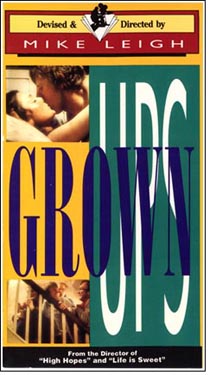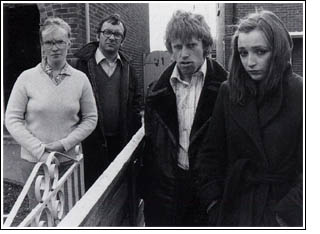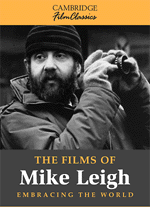|
 The
great characters in Leigh's films are asked to do the same thing the actors
he directs are: to become ensemble players, masters and mistresses of
supple, fluid responsiveness. For Leigh, partnering is what both art and
life are fundamentally about. In this respect, his aesthetic goes against
the grain of American film acting, where the goal is not ensemble playing
but "starring." Everything in the American system works to create
star players. American viewers are attracted to star names; American directors
tailor their scripts to feature stars; and the American publicity system
rewards stars financially. Even most American critics are captive to the
power of the star. When an actor such as Orson Welles, Jack Nicholson,
Harvey Keitel, or Meryl Streep goes on a riff, steals a scene, chews the
scenery, or serves up a big, fat emotion under glass, the pros and cons
of the particular moment may be discussed, but the very notion of understanding
experience in terms of stars or starring performances is almost never
questioned. The
great characters in Leigh's films are asked to do the same thing the actors
he directs are: to become ensemble players, masters and mistresses of
supple, fluid responsiveness. For Leigh, partnering is what both art and
life are fundamentally about. In this respect, his aesthetic goes against
the grain of American film acting, where the goal is not ensemble playing
but "starring." Everything in the American system works to create
star players. American viewers are attracted to star names; American directors
tailor their scripts to feature stars; and the American publicity system
rewards stars financially. Even most American critics are captive to the
power of the star. When an actor such as Orson Welles, Jack Nicholson,
Harvey Keitel, or Meryl Streep goes on a riff, steals a scene, chews the
scenery, or serves up a big, fat emotion under glass, the pros and cons
of the particular moment may be discussed, but the very notion of understanding
experience in terms of stars or starring performances is almost never
questioned.
Leigh regards "starring"
(in life and in art) not as a triumph but a problem. In his dramatic
universe the goal is not to solo but to partner; not to stand out
but to fit in. Acting is interacting. Beverly shows what Leigh thinks
of stars. Like a bad television talk-show host, she dominates every
conversation, controls every beat, and fights to avoid being upstaged
by anyone; but the work she is in clearly reveals Beverly's devotion
to star-turns to be a moral nightmare. To star is to ignore others'
needs. Peter in Bleak Moments, Mr. Thornley in Hard Labour,
Keith in Nuts in May, June in Home Sweet Home,
and Johnny in Naked cast themselves as the stars of the
scenes in which they appear. They talk at but never really
with anyone they meet. None of them can put his own emotional
needs aside long enough to interact with anyone in a flexibly responsive
way. (As Peter and Johnny in particular demonstrate, these figures
run in terror from the prospect of giving up even a little control,
sharing even a little emotional space with anyone else.) Leigh shows
how horrific their starring is. Jack Nicholson's or Harvey Keitel's
domination of screen space and upstaging of other actors is never
critiqued by their own works in this way.
According to Leigh's
work, our supreme creative achievements do not come by "starring",
but by interacting. His greatest characters are asked to
engage in delicate dances of interactional awareness and adjustment
in which they complexly partner each other. Partnering can take
many different forms–from the minor-key game playing of Sylvia
with Norman and Hilda in Bleak Moments and the brief dance
of affection that takes place between Naseem and Ann in Hard
Labour, to the more intricate pas de deuxs performed
in certain scenes in Four Days in July, Ecstasy, and
Meantime, to the evening-length ballets of High Hopes
and Life Is Sweet.
The preceding should
suggest that the much-praised ensemble performances in Leigh's work
are not just an accidental side effect of his rehearsal methods.
They are at the heart of his vision of experience. For Leigh (as
for Renoir), we are essentially not individuals, but members of
a group. We share our identities with others and define ourselves
in interaction with them. Identity is relational.
At the same time, it
is important to add that, for Leigh (as for Renoir), the interactional
nature of life does not in the least entail leveling, homogenizing,
or eradicating individual differences. In fact, it maximizes them.
To watch any of Leigh's works is to be plunged up to your eyeballs
in expressive idiosyncrasy and bodily uniqueness. It is to be circulated
through an almost dizzying variety of different ways of talking,
moving, thinking, and feeling–each of which is honored. In every
possible way, Leigh's casting, scripting, and photography communicate
his supreme respect for personal differences. It is not unimportant
that one of Beverly's shortcomings in Abigail's Party (like
Melody and Dave in Home Sweet Home) is that she erases or
ignores differences in thought and feeling (as when she assumes
Sue feels the same way she does about divorce). Her smug knowingness
prevents anyone from differing from her understanding of them.
 Respect
for individual differences may not sound as unusual as it is, but
in fact the overwhelming majority of films (and scripts) unconsciously
tend to privilege a particular way of thinking, feeling, or speaking.
In mass-market films, the preferred view is usually that of the
middlebrow viewer the film is meant to appeal to and not confuse
or offend, so that any character with the least degree of expressive
individuality is treated as being eccentric or weird. In many art
films one can hear a particular screenwriter's "voice"
emerging from every characters' mouth–Woody Allen's most interesting
characters all sounding like little Woody Allens and Orson Welles'
like versions of him. These films are a kind of one-man puppet show.
To the extent that a character has the "right" sound or
set of feelings, we are meant to admire him or her. And if a character
acts, thinks, or feels differently from the director's or screenwriter's
ideal, we are meant to judge him negatively (or regard him as a
kook). Respect
for individual differences may not sound as unusual as it is, but
in fact the overwhelming majority of films (and scripts) unconsciously
tend to privilege a particular way of thinking, feeling, or speaking.
In mass-market films, the preferred view is usually that of the
middlebrow viewer the film is meant to appeal to and not confuse
or offend, so that any character with the least degree of expressive
individuality is treated as being eccentric or weird. In many art
films one can hear a particular screenwriter's "voice"
emerging from every characters' mouth–Woody Allen's most interesting
characters all sounding like little Woody Allens and Orson Welles'
like versions of him. These films are a kind of one-man puppet show.
To the extent that a character has the "right" sound or
set of feelings, we are meant to admire him or her. And if a character
acts, thinks, or feels differently from the director's or screenwriter's
ideal, we are meant to judge him negatively (or regard him as a
kook).
The virtuosic visual
and acoustic styles of many films are other ways of leveling individual
differences (as when the spooky lighting in a thriller makes all
the characters scary or the Top 40 sound track in another makes
everyone seem hip). Critics are fond of praising the "vision"
of filmmakers who make highly stylized films, but the downside of
this so-called vision is its blindness to other ways of feeling
and being. The style swallows everything in its path and assimilates
it to its purposes. The potential uniqueness of everything and everyone
in the work is at least slightly attenuated.
The magisterial, omniscient
view of characters and situations offered by the Hitchcock film
is another form of simplification. Hitchcock's style promotes one
way of seeing everything and rejects all others. Characters in Hitchcock's
works who can't "see" (in both the optical and imaginative
sense of the term) things in his way are invariably punished
by the plot (by being either murdered or stalked). Leigh goes as
far as possible in the other direction. He doesn't level, filter
or homogenize the view. He shows us that there can be many different
attitudes, many different ways of understanding, many different
points of view in any one moment, no one of which is necessarily
better or truer than any other. In any gathering of people, there
is always more than one way of encountering experience. His work
is an exultant celebration of the diversity of views, tones, and
feelings....
–Excerpted from Ray
Carney, The Films of Mike Leigh: Embracing the World (London
and New York: Cambridge University Press, 2000).
To read more about
critical fashions, see the essay "Sargent and Criticism"
in the Paintings section, "Capra and Criticism"
in the Frank Capra section, and "Skepticism and Faith,"
"Irony and Truth," "Looking without Seeing,"
"Art as a Way of Knowing," and other pieces in the Academic
Animadversions section.
 |
  |
Ray
Carney's The Films of Mike Leigh is quite simply the
best book of film criticism I have ever read.
Now I have to say
that I have never read any of Carney's other books (he has
also written books on Cassavetes, Frank Capra, and Carl Dreyer),
which, for all I know, might be even better. But as a friend
of mine put it, 'His writing blows everything else out there
away, even to the point of many times seeming like simply
in a class of his own...different in kind more than degree.'
And although I admit to not having read 'everything else out
there,' I feel the exact same way. Ray Carney's new book has
undeniably rocked my world.
Ray Carney's book
is to what usually passes for film criticism what Mike Leigh's
movies are to what, in Hollywood, usually passes for filmmaking:
a truly radical critique, a whole different animal, and a
solitary voice of sanity that has somehow miraculously managed
to make itself heard over the noise and hullabaloo of this
culture's present-day insanity. |
|
–Caveh
Zahedi, creator of A Little Stiff and I Don't Hate
Las
Vegas Anymore,
in a review in Filmmaker Magazine |
| |
  |
| |
Mike Leigh’s work is difficult to pin down. Echoing what Ray Carney says of Leigh’s more blinkered characters, examining these films becomes a lot murkier when you bring too many ideas and film-critical categories to bear. Although not without its strengths and serendipities, Garry Watson’s book suffers from intellectual larding while, like one of Leigh’s more far-sighted characters, Carney and Quart’s gets in amongst the rough-and-tumble....
The Carney and Quart book was the first critical study of Leigh’s work and every subsequent book on Leigh must negotiate its rigor and insight. I have yet to read a book that better approximates my experience of watching Leigh’s films.My one regret is that, apart from the important BBC plays Nuts in May and Abigail’s Party (1977), I have yet to see many of the early works wherein Carney locates the wellspring of Leigh’s improvisatory power and vision.
Animating this study is a distinction between two types
of Leigh characters that resonates culturally, politically and
spiritually across his work. For Carney, there are those like
Rupert and Laetitia Boothe-Braine in High Hopes (1988),
Nicola in Life Is Sweet (1990), and Sebastian in Naked (1993)
who, mired in a mental image of themselves, pigeon-hole
others in prejudices, effectively foreclosing on generous and
responsive solidarity. Then there are those like Cyril and
Shirley in High Hopes, Wendy in Life Is Sweet, and Louise in Naked who have all the foibles, strengths, and self-doubts of
their humanity, and are open to the flows of human interaction.
Alison Steadman’s giggly and affectionate Wendy still
epitomizes the principle of social cohesion in Leigh. It is perhaps
unsurprising that Steadman and Leigh were married,
while the positive response to the density of experience recalls
the thick descriptive methodology through which a Leigh
film is arrived at. Evoking the Dickensian and Lawrentian
views of human sensibility (as Watson points out), Leigh feels
that the individual mindset has consequences for the wider
culture, and by this light the generous impulse in Wendy and
other Leigh characters has been eroded by consumerism and
social mobility in postwar Britain. Not as overtly political as
Ken Loach, Leigh has nevertheless chronicled the domestic
consequences of the decline of the social consensus imagined
by writers from Dickens to George Orwell.
One of the most unexpected aspects of Carney and Quart’s book is the way it puts mainstream American cinema in perspective by comparing it with Leigh’s cinema.With his focus on characters as mannered and tic-ridden “outsides” (as opposed to Hollywood’s granting us access to Forrest Gump’s inner kindness despite the goofy exterior), Leigh charts that elusive quality, the “ordinary” moment—the everyday drama of interaction they never show in Hollywood because it occurs between the heroics.
In doing so, Carney shows, Leigh pulls apart the Enlightenment model of agency and volition on which most American movies depend. Recalling classes he has taught—he is Director of Film Studies at Boston University—Carney describes how Americans are often perplexed by a cinema in which nothing seems to happen. But Leigh’s drama of transformation is rooted in the layered rehearsal of interpersonal dynamics observed with the patience of a European Ozu. Whilst British Leigh commentators have been preoccupied with the writer-director’s purchase on the sociological landscape, Carney convinces us that Leigh and Ozu share a feeling for the interplay of performance and mise-en-scène which moves beyond David Bordwell’s pioneering Ozu dichotomy between modernism and tradition. Leigh’s conception of experience (unlike that of Hollywood) is durational rather than deadlined, heterogeneous rather than hurried. Carney’s examination of space and time in Leigh reveals, as Bordwell has done elsewhere, that the mainstream model of experience conceals as much as it reveals.... |
| |
–Richard Armstrong, a review of Gary Watson, The Cinema of Mike Leigh and Ray Carney and Leonard Quart, The Films of Mike Leigh: Embracing the World, published in Film Quarterly, Dec 2005, Vol. 59, No. 2, pp. 62-63 |
| |
  |
| |
No other study sheds such a revealing light on Leigh's background, his influences, his emotional groundings, and, of course, his unique cinematic sensibility....[Carney's The Films of Mike Leigh is a] powerful and multifaceted analysis which welcomes, like Leigh's work, the vibrant eye and the uncalcified consciousness.
|
| |
-- Andrew Hamlin, in a review of Ray Carney's The Films of Mike Leigh: Embracing the World, published in MovieMaker Magazine. |
| To learn
how to obtain this book, click
here |
|










